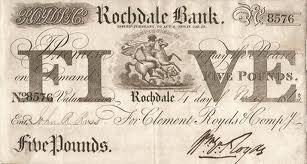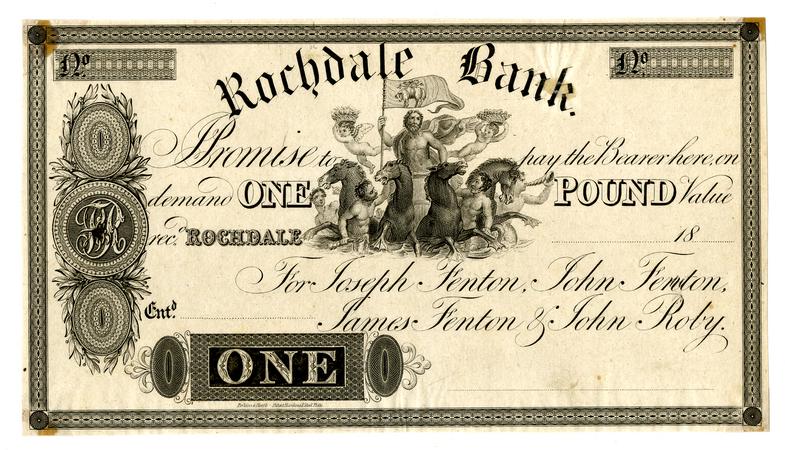The Rochdale Bank

Traditional banking services such as accepting deposits and money lending only became
commonplace by the 17 th century in Britain when transferring funds was combined with the issuing
of notes as a substitute for gold and silver coins. The industrial revolution in the United Kingdom
however, meant that there needed to be more and more safe places for the increased amounts of
local money in circulation from trade as well as agencies where payment and transfer could be made
conveniently. The rise of the cotton industry in towns such as Rochdale inevitably led to the call for a
place to ‘bank’ funds as well as institutions through which international trade could be connected
and regulated. However it was not until the middle of the 19 th century that commercial banks
located in towns could issue their own banknotes.

One such bank was set up in Rochdale in 1811 with ties, not immediately as would have been
imagined with Manchester and the cotton trade, but with Yorkshire and the woollen industry. This
was because, prior to that, the canal from Yorkshire through Rochdale was providing a lucrative
early trade route for textiles. With its 31 miles and 92 locks the canal’s existence owed a great deal
to the Royds family of Rochdale who saw the canal system as a great commercial opportunity. John
Royds financed a preliminary survey concerning the Rochdale Canal in 1766 although it was
successfully opposed. However, Royds revived the scheme in 1790 and with difficulty obtained the
necessary Act of Parliament which meant that before very long money was passing commercially
along the Calder and Roch valleys via the town’s canals. Reliable banking therefore was required
along this route more than ever.
There had been numerous Halifax banks before them but the one owned by John, William and
Christopher Rawson was the one which Rochdale businessmen reached out to, initially offering a
weekly banking service in Yorkshire Street and on market days. By 1818-19 this bank was firmly
established at The Butts and under new ownership was printing and distributing its own bank notes.
The Rawson family moved into the house and conducted their business from an annex which still
stands as the sandstone building at the entrance to The Butts to the left of what became the Royal
Bank of Scotland. There, above the door of the single-storey building you can still see a relief panel
reading ‘BANK’.

In 1872 the business was sold to Clement Royds and re-named the Bank of Royds, Smith and Co. It
had a London agent (Jones Lloyd and Co) and in time became known as the ‘Rochdale Old Bank.’ The
canal and wool trade connection continued with this bank because Clement Royd who was
sometimes known as ‘the canal banker’ was also operating as a woollen merchant at that time.
Always the entrepreneur, he expanded his banking interests further in 1827 by buying out
shareholders such as Rhodes and Briggs so that the bank – initially becoming Royds, Smith and Co –
later became Clement Royds & Co., Royds remaining a senior partner at the bank until his death in
1854.
During this period, notes and coins were issued from this Rochdale bank and shares offered and
bought by industrialists in the area. When Clement Royds died in 1854, his sons Albert and William
Royds succeeded him at the bank but at that point they stopped issuing banknotes. The next decade
saw the next generation of Royds stepping into the Rochdale banking world as around 1867
Clement Molyneux Royd the High Sheriff of Lancashire became partner and (in 1875) a senior
partner at the bank.
When another local bank – J and J Fentons – closed down in 1878 the Royds family, who were still
involved in banking in the town, saw the writing on the wall for small, private banks and so procured
an amalgamation of their bank with a Manchester and Salford Bank which transferred to the Union
Bank of Manchester in 1881, selling their ownership for £43,000. The choice of a Manchester bank
at that time suggests that the old links with wool and Yorkshire were now over. In time, what
remained of a Rochdale bank became part of William Deacon’s Bank, then William and Glyns
although Sir Clement Royd was still involved as chairman in 1906.